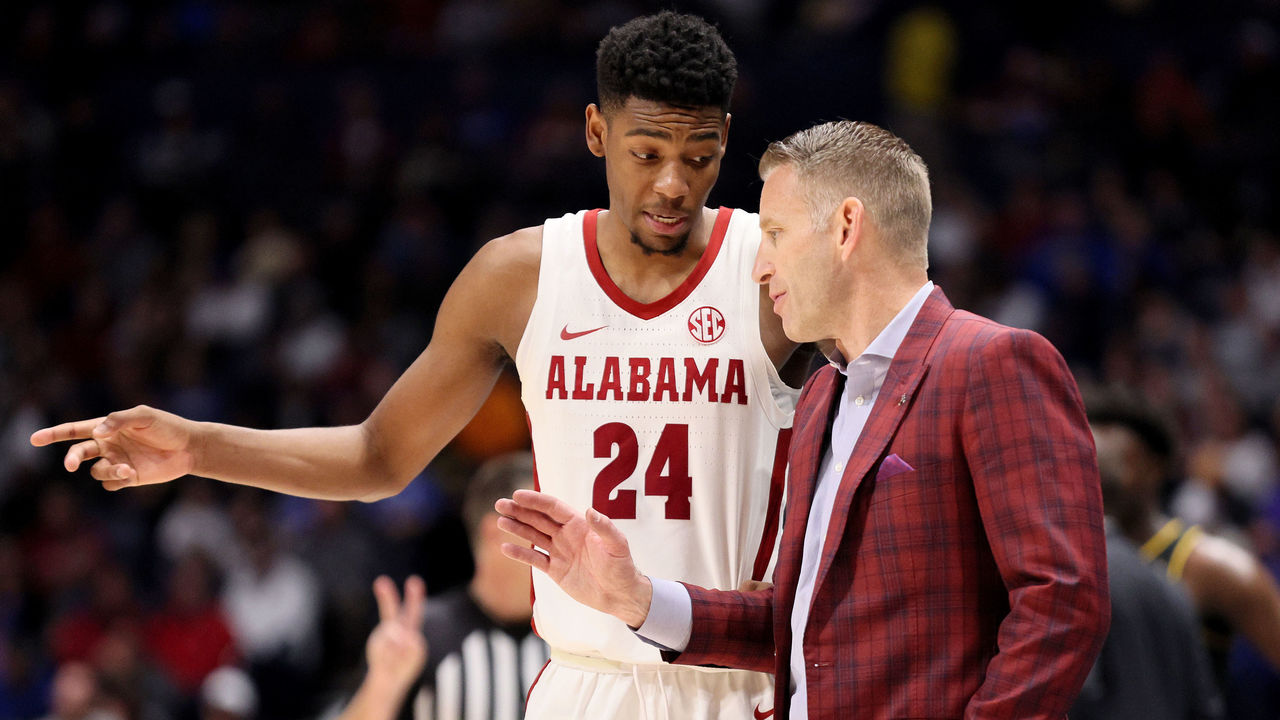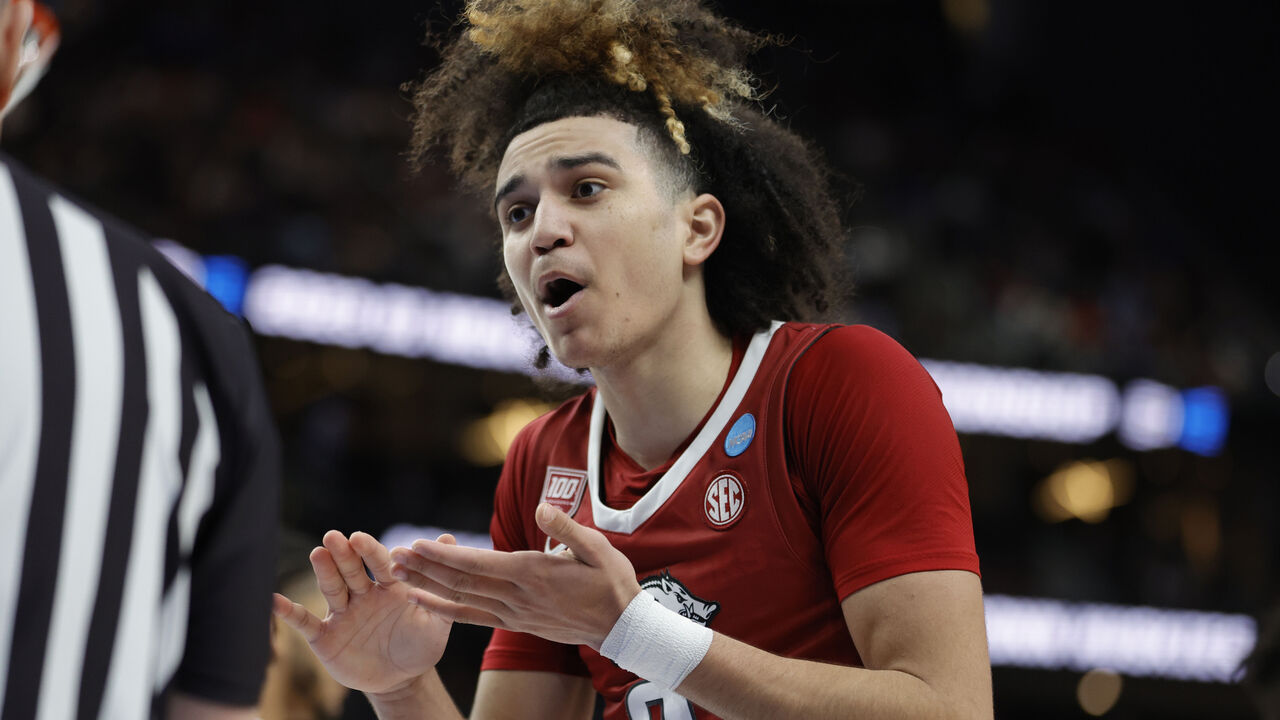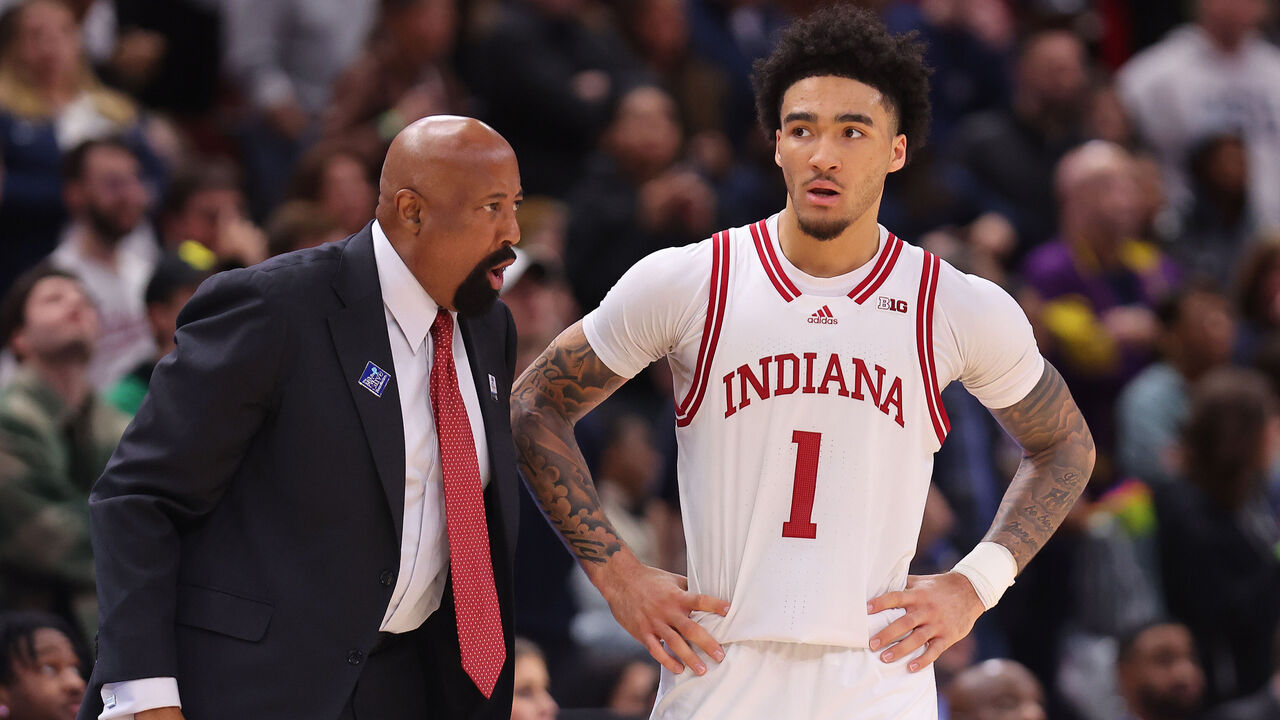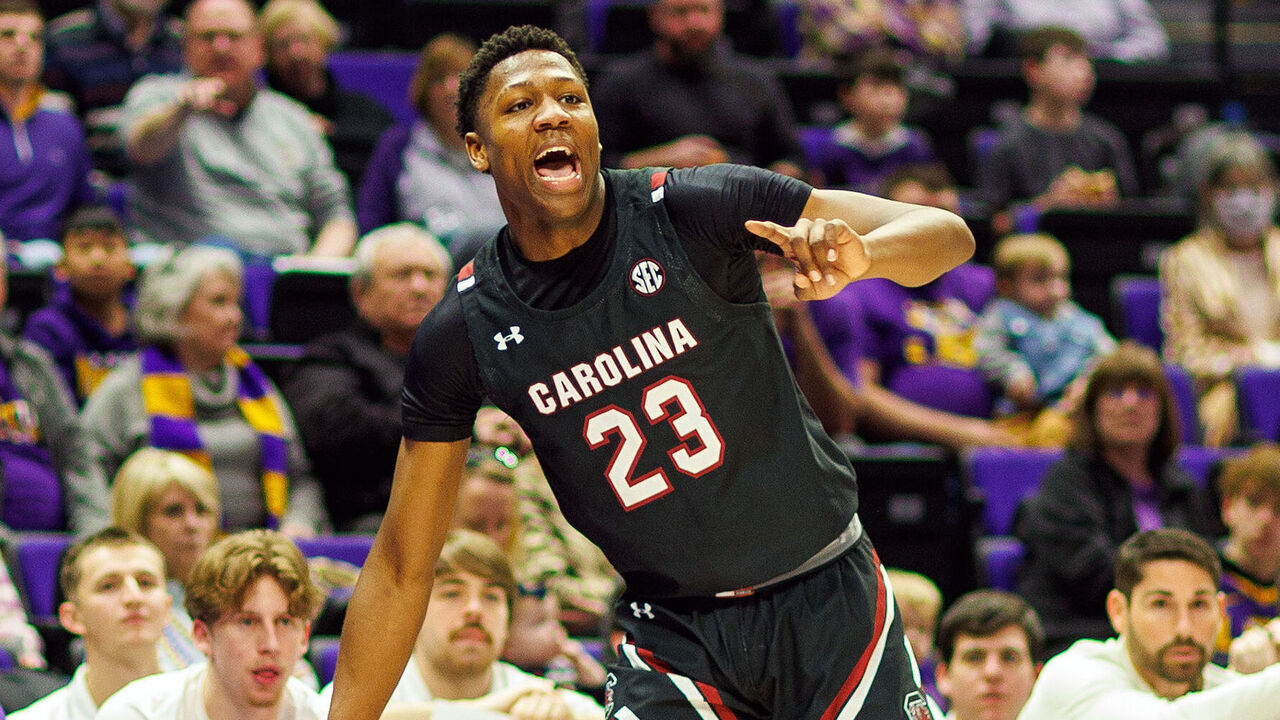2023 NBA Mock Draft: Taking stock after March Madness
On the heels of an NCAA men's Division I basketball tournament full of twists, turns, and unfathomable results, many of March Madness' standout stars now turn their attention to the 2023 NBA Draft.
Here's a look at our latest mock draft, accounting for those who've seen their stock rise and fall since we last forecasted June's marquee event.
1. Detroit Pistons - Victor Wembanyama, F, Metropolitans 92
Wembanyama has been the consensus No. 1 pick for quite some time, but he's still finding new ways to blow our minds. The Frenchman's latest jaw-dropping highlight came last weekend when he threw down a one-handed putback jam off his own step-back 3-point attempt. The sequence is another reminder of why Wembanyama is being billed as the greatest prospect since LeBron James.
He's a 7-foot-4 shot-creator who can score at all three levels and possesses a release that's virtually unblockable. Wembanyama can pull up from deep in transition, hit jumpers coming off screens, and hit tough fadeaways in the post. His defensive chops are equally impressive as he provides elite rim protection and can quickly close out shooters using his 8-foot wingspan. Detroit shouldn't think twice about selecting Wembanyama.
2. Houston Rockets - Scoot Henderson, G, G League Ignite
Lost in the bright lights of March Madness and the ever-growing hype surrounding Wembanyama, Henderson isn't being talked about nearly as much as he was in the fall. A lot of those concerns stem from his shooting - he made just 27.5% of his 3-pointers across 19 games this season before getting shut down. He averaged only 2.7 attempts per game from beyond the arc.
At 6-foot-2, Henderson is the shortest player projected to go in the first round. All this to say, the electric point guard will need to improve his outside jumper or be so dominant with the ball in his hands that his size and shooting won't matter if he wants to live up to his draft billing. That play style has served some like Russell Westbrook and Ja Morant well, but it can also be a risky proposition for a club picking second.
3. San Antonio Spurs - Brandon Miller, F, Alabama

The past few months have been a roller coaster for Miller, starting with his off-court issues in February. Miller then played some of his best basketball to end the regular season and was seen as a candidate for the No. 2 spot but shot a historically poor 8-for-41 (19.5%) in Alabama's three March Madness games.
Miller has a near perfect game for the NBA. He's a long 6-foot-9 and has an excellent 3-point stroke, and he has increasingly grown as an on-ball playmaker for himself and others. His shot selection can sometimes be shaky, and he'd do well to add some weight, but there's no denying his immediate fit for whichever team drafts him. A jumbo-sized, sweet-shooting wing like Paul George could ultimately be his ceiling.
4. Charlotte Hornets - Amen Thompson, G/F, Overtime Elite
Thompson's athleticism is the first thing that jumps out. The 6-foot-7 guard is explosive off the bounce and a threat above the rim. He's a terror in the open floor with his ball-handling skills, blazing speed, and court vision. While Thompson's jumper is a work in progress, he makes great use of hesitation moves to get to his spots in the paint and has the strength to finish through contact. Thompson has also displayed a soft touch on runners and the ability to find open shooters when he draws double teams.
Defensively, he keeps his hands active and stays glued to his counterpart on and off the ball. Thompson is also a solid help defender, often rotating to provide some rim protection or closing out on the perimeter.
5. Portland Trail Blazers - Cam Whitmore, F, Villanova
Despite playing in a college system at Villanova that didn't quite fit his game, Whitmore showed flashes of potential NBA stardom throughout his freshman season. There simply aren't many powerful 6-foot-7 wings who can hit open threes with consistency. While his jumper took some time to come around, Whitmore hit over 42% of his long balls in his final five games with increased freedom.
Whether Whitmore can develop as a playmaker will be the difference between him becoming a high-level 3-and-D forward in the mold of OG Anunoby or a player with a more all-around scoring repertoire like Keldon Johnson. Either way, his combination of size, bounce, and shooting makes him a can't-miss selection at the tail end of the top five.
6. Indiana Pacers - Jarace Walker, F, Houston
Walker is as physically imposing a player as you'll find in this draft class. The 6-foot-8, 240-pound beast from Houston is an elite rebounder and shot-blocker who has the versatility to potentially defend all five positions at the next level. He'll immediately become a top defensive option for an NBA team.
The questions are on the offensive end. After hitting 42.3% of his 3-pointers across his first 23 games of the season, Walker only made 26.5% over his final 13 contests, with his shots almost exclusively being catch-and-shoots. His passing is underrated, though, with his 12.6 assist rate nearly quadrupling the college numbers of Bam Adebayo, a similarly built player who's become a strong passer in the NBA. If he can grow on that end in a similar way, he has an All-Star-level ceiling.
7. Orlando Magic - Ausar Thompson, F, Overtime Elite
Ausar Thompson may not have the same unreal athleticism his brother, Amen, possesses, but he can still jump out of the gym, and his game is arguably further along. Playing off-ball with his brother manning the point, Thompson still has solid vision and a feel for the game.
Thompson may be the best blend of ability and projectability at the next level. At worst, he's a slasher and playmaker in the open floor. At best, he'll reel in his athletic ability and improve his jump shot to become a near All-Star-caliber player.
8. Washington Wizards - Gradey Dick, F, Kansas
Dick immediately stepped into a starting role and thrived in arguably the toughest conference in college basketball. The teenager shot 40.3% on nearly six triples per game to go along with 5.1 boards and 1.4 steals per contest. He's got NBA range, smooth shooting mechanics, and was a weapon in dribble-handoffs and off-ball screens.
Dick can also put the ball on the floor and is a superb finisher around the rim. The 6-foot-8 wing is a good rebounder for his position and has the size and length to potentially develop into an impact defender. He does a solid job getting his hands in passing lanes and flashed some playmaking skills in the pick-and-roll.
9. Utah Jazz - Anthony Black, G, Arkansas

Black was one of three five-star prospects in Arkansas' loaded 2022 recruiting class. The 6-foot-7 guard showed his two-way potential in the Razorbacks' season-ending loss to UConn, tallying 20 points, five steals, and four rebounds against the eventual national champion. He attacked the rim aggressively, created turnovers with his quick hands and ball pressure, and was active on the glass.
While Black registered just one assist versus the Huskies, he excelled in a lead playmaking role throughout his lone year in Fayetteville. The 19-year-old amassed the second-most dimes in the SEC (141) and ranked 14th in the conference with an assist percentage of 20.6%. He can launch the ball upcourt in transition, create for others out of the pick-and-roll, and find openings with his elite size.
10. Dallas Mavericks - Cason Wallace, G, Kentucky
Wallace has a strong claim to be the best guard defender in the draft. At a long 6-foot-4 with excellent instincts for steals and the quickness to stay in front of his defender, he'll quickly earn a reputation as a perimeter pest.
Unlike many defense-first guards, his shot seems relatively well-put-together, as he made 44 threes at a 34.6% clip this season and showed promise as a driver toward the rim. Questions remain about him potentially being a true point guard, as he'd be slightly undersized as a 2-guard if he can't become an elite shotmaker.
11. Oklahoma City Thunder - Taylor Hendricks, F, UCF
Hendricks is exactly the type of prototypical wing who teams fall in love with after watching through the pre-draft process. After all, there probably weren't many watching him play for a 19-15 UCF team this season. The rangy 6-foot-9 wing shot a blistering 39.4% from deep while posting an elite 6.2% block rate. He's the first freshman in Basketball Reference's 14-year existence to put up those numbers.
The Floridian will most likely become a very useful player, one who makes open threes, protects the rim, and guards multiple positions while not needing tons of shots to be successful. At just 18 years old, Hendricks could jump into the top 10 if teams see an even higher ceiling.
12. Orlando Magic (via CHI) - Keyonte George, G, Baylor
George had an up-and-down year at Baylor. The McDonald's All-American flashed his scoring prowess, finishing ninth in the ultra-competitive Big 12 in scoring (15.3 points per game) and registering at least 20 points on 12 occasions. He consistently got to the charity stripe and played with plenty of energy on the defensive end.
However, he shot just 33.8% from deep and 37.6% overall. The five-star freshman also racked up the third-most turnovers (95) in the conference. For George to succeed at the next level, he'll need to improve his shot selection and decision-making.
13. Utah Jazz (via MIN) - Jordan Hawkins, G, UConn
Hawkins boosted his draft stock as one of UConn's lead horses during the Huskies' title run, averaging 16.3 points and shooting 50% from deep across six NCAA Tournament games. His 109 triples on the season led the Big East and ranked 12th in the nation.
Hawkins has drawn comparisons to UConn great Richard Hamilton as they both excelled moving without the ball. The sophomore guard's footwork, quick release, and body control allow him to be an effective shooter coming off screens. Hawkins' 3-point efficiency opened up opportunities to attack overly aggressive closeouts and cut to the basket.
14. Toronto Raptors - Nick Smith, G, Arkansas
The season did not go according to plan for Smith after being ranked as ESPN's No. 3 recruit heading in. He missed most of the early campaign due to injury and wasn't very effective when he did suit up for Arkansas. His 12.5 points, 1.7 assists, and 1.6 rebounds per game on 37.6% shooting from the field are far from encouraging.
Still, there's a reason Smith was ranked so highly coming out of high school. His scoring and playmaking ability at 6-foot-5 will make him a hot commodity if he can put everything together. His participation in parts of the draft combine could really help him.
15. Atlanta Hawks - Jalen Hood-Schifino, G, Indiana

Once Indiana lost starting point guard Xavier Johnson to a season-ending injury, Hood-Schifino showed excellent poise, vision, and mid-range shotmaking as the new lead ball-handler. He sometimes lacked consistency, but his reads out of the pick-and-roll and ability to get to his spots are at an NBA level. Add in his quality size at 6-foot-6, and he could potentially run an NBA team's second unit next season.
16. New Orleans Pelicans - Brice Sensabaugh, F, Ohio State
Sensabaugh was a bright spot during a down year for Ohio State, averaging 16.3 points and shooting 40.5% from distance at the fourth-highest usage rate in the nation. The 6-foot-6 wing was a catch-and-shoot threat and an efficient mid-range scorer. Sensabaugh's limitations as a playmaker and defender are concerning, but his shot-creating ability will appeal to teams in need of some offensive punch.
17. Los Angeles Lakers - Jett Howard, F, Michigan
Howard spent his lone collegiate season playing for his father, Juwan. The 19-year-old's best trait is his shooting. He finished third in the Big Ten in both 3-point percentage (36.8%) and total triples (78). Howard got some valuable experience in a pro-style offensive system, running the pick-and-roll and draining jumpers from beyond the arc off movement.
18. Houston Rockets (via LAC) - Dereck Lively, C, Duke
After a dead-silent start to his freshman campaign, former No. 1 recruit Lively looked like the country's best defensive player to close out the season. The 7-foot-1 big man used his massive wingspan to average three blocks over his last 18 contests, and he finished the season with the best defensive box plus-minus in the nation. His offense is completely limited to putbacks and lobs, but he could immediately slot into an NBA rotation on the strength of his defense alone.
19. Golden State Warriors - Kris Murray, F, Iowa
Murray made a similar leap as his brother, Keegan, and is poised to also become a first-round selection following a breakout year. In his first full campaign as a starter, he averaged 20.2 points, 7.9 boards, two assists, 1.2 blocks, and one steal. Murray earned All-Big Ten first-team honors and was among 20 players on the late-season Wooden Award watch list. He provides floor-spacing as a catch-and-shoot threat and is capable of defending multiple positions. Murray should make an instant impact in his rookie campaign.
20. Miami Heat - Leonard Miller, F, G League Ignite
After nearly declaring for the draft last year, Miller has broken out for the G League Ignite in the regular season, averaging 18 points and 11 rebounds per game, while making 55.6% of his field goals. Everything about Miller's game is unconventional, from his lean 6-foot-10 frame to his awkward yet somewhat effective shooting release. Given the spacing, size, and creativity that the modern NBA allows its players, Miller could thrive at the next level.
21. Brooklyn Nets - Rayan Rupert, F, New Zealand Breakers

Rupert is the latest teenage NBA prospect to have joined the Australian NBL through its Next Stars program. The 18-year-old Frenchman is a graduate of the INSEP Academy, which has produced the likes of Tony Parker and Boris Diaw. Rupert is averaging 6.6 points and 2.5 boards in limited minutes for the New Zealand Breakers. His numbers don't jump off the charts, but he's an intriguing defensive prospect. Rupert stands 6-foot-7 and boasts a 7-foot-3 wingspan. He's shown great mobility and is a tenacious on-ball defender. Rupert's development on the other end of the floor will take some time but may be worth the wait.
22. Brooklyn Nets (via PHX) - Dariq Whitehead, G, Duke
Much like Lively, his Blue Devils teammate, Whitehead got off to a slow start this season, though much of that was due to injury. The 6-foot-7 guard led the ACC in shooting 45.9% from beyond the arc in conference play and looked progressively more comfortable scoring off the dribble. While this pick is largely based on his potential as a shotmaker, his hot run to close the campaign is a bonus for teams selecting in the late teens and early 20s.
23. Portland Trail Blazers (via NYK) - Noah Clowney, F, Alabama
Clowney is the second Crimson Tide player to go off the board. The 6-foot-10 forward amassed the fourth-most rebounds in the SEC (285) and finished ninth in the conference with 34 blocks. He converted over 70% of his attempts at the rim and consistently played with a high motor. Clowney is an ideal fit in the modern NBA with the lateral movement to adequately guard players on the perimeter and the shooting mechanics to potentially develop into a floor-spacing threat.
24. Sacramento Kings - Kyle Filipowski, F, Duke
Filipowski emerged as Duke's most impactful player this season, pacing the Blue Devils in points (15.1 per game), rebounds (nine), and steals (1.3). The 7-footer can space the floor, post up, handle the rock, and has the agility to defend in space. Despite his size, Filipowski lacks the length to be an imposing rim-protector and struggled to score through contact at the rim.
25. Indiana Pacers (via CLE) - Kobe Bufkin, G, Michigan
Bufkin went from a seldom used reserve in his first year to a starter in all 33 games as a sophomore. The Wolverines guard got better as the campaign progressed, averaging 17.4 points, 6.1 boards, 3.3 assists, and 1.2 steals over his last 12 appearances. He was an excellent finisher around the basket, converting 75% of his attempts. Bufkin also has the flexibility to play on and off the ball. He's capable of hitting teammates on the pick-and-roll and shot 35.5% from downtown.
26. Memphis Grizzlies - Colby Jones, G, Xavier
Jones put together an extremely well-rounded stat line of 15 points, 5.7 rebounds, and 4.4 assists per game while making 50.9% of his field goals and 37.8% of his 3-pointers, numbers rarely been matched by high-major guards in recent years. He isn't overly dynamic as an on-ball scorer, but his ability to help in multiple areas makes him extra valuable for a team that isn't fishing for boom-or-bust prospects to close out the first round.
27. Utah Jazz (via PHI) - GG Jackson, F, South Carolina

Jackson's shot-creating skills could allow him to sneak into the first round. The 6-foot-9 forward likes to create separation from defenders on step-backs and can pull up from the mid-range or long distance. His 215-pound frame enables him to post up opposing players and finish through contact. However, Jackson was an inefficient scorer and was turnover-prone. There are also concerns about his character after he called out South Carolina's coaching staff on social media following a regular-season loss.
28. Charlotte Hornets (via DEN) - Maxwell Lewis, F, Pepperdine
It was a tale of two seasons for Lewis at Pepperdine. Through his first 19 games, the swingman averaged a pristine 19.6 points on hyper-efficient 52/41/83 splits. Then, in his final 13 contests, those numbers plummeted dramatically to 13.1 points on ugly 37/23/72 shooting. Lewis isn't overly athletic and doesn't have a phenomenal motor, so his game is heavily reliant on shooting. Teams will have to determine which version of Lewis better represents his ability.
29. Indiana Pacers (via BOS) - Julian Strawther, F, Gonzaga
Strawther took over the starting small forward role after Corey Kispert's departure two years ago. The junior was a dependable co-star alongside Drew Timme, posting 13.7 points per contest and drilling nearly 40% of his 3-point field goals. Strawther provides floor-spacing as a catch-and-shoot threat and has a floater in his toolbox when forced to put the ball on the floor. Although Strawther works hard on the defensive end, he hasn't produced many steals or blocks over his three years in Spokane.
30. Los Angeles Clippers (via MIL) - Andre Jackson, F, UConn
Jackson is already 21, averaged just 6.7 points this season, and is only 6-foot-6. And yet, his game is exactly where the NBA is headed at the 4-spot. While he'd do well to knock down open jumpers more often, his elite athleticism, phenomenal passing vision, and overall basketball IQ are instrumental to a team's success. Case in point: Jackson was rated as the country's third-most valuable player by EvanMiya.com despite being the sixth-leading scorer on his championship-winning UConn squad.